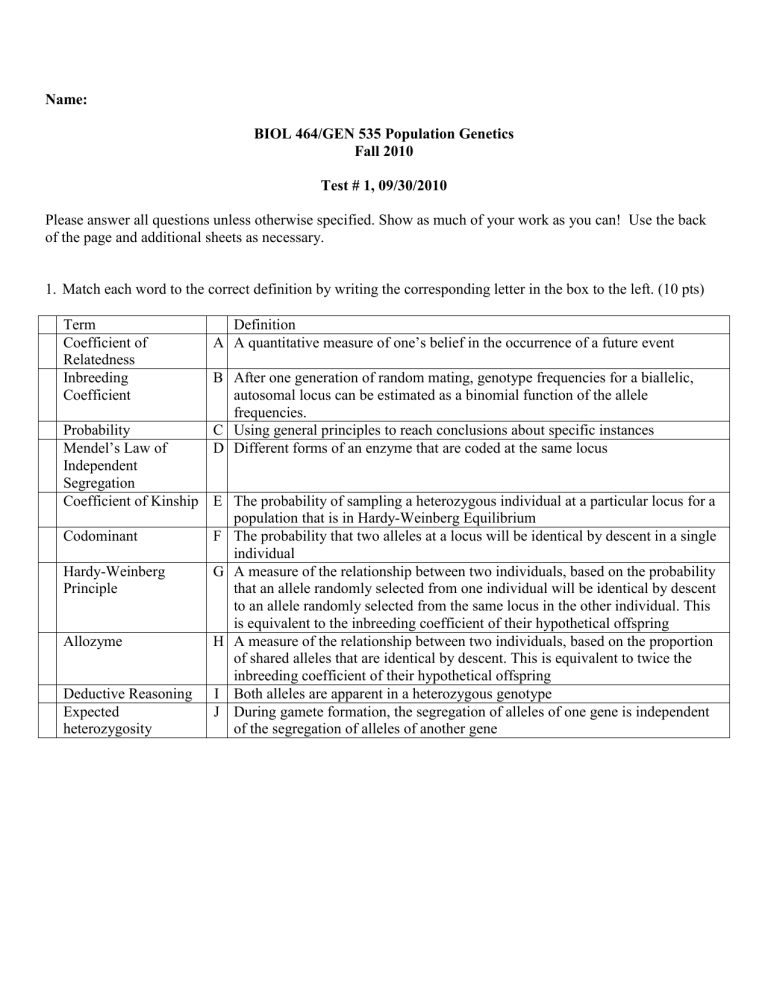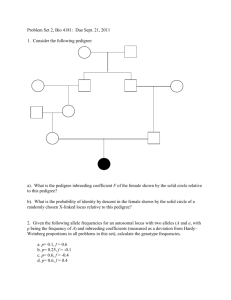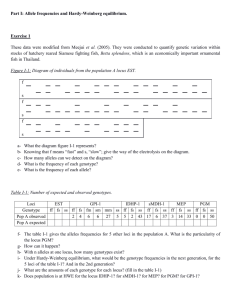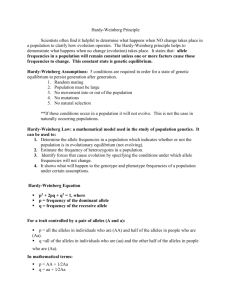BIOL 464/GEN 535 Population Genetics

Name:
BIOL 464/GEN 535 Population Genetics
Fall 2010
Test # 1, 09/30/2010
Please answer all questions unless otherwise specified. Show as much of your work as you can! Use the back of the page and additional sheets as necessary.
1.
Match each word to the correct definition by writing the corresponding letter in the box to the left. (10 pts)
Term
Coefficient of
Relatedness
Inbreeding
Coefficient
Probability
Mendel’s Law of
Independent
Segregation
Definition
A A quantitative measure of one’s belief in the occurrence of a future event
B After one generation of random mating, genotype frequencies for a biallelic, autosomal locus can be estimated as a binomial function of the allele frequencies.
C Using general principles to reach conclusions about specific instances
D Different forms of an enzyme that are coded at the same locus
Coefficient of Kinship E The probability of sampling a heterozygous individual at a particular locus for a population that is in Hardy-Weinberg Equilibrium
Codominant F The probability that two alleles at a locus will be identical by descent in a single individual
Hardy-Weinberg
Principle
G A measure of the relationship between two individuals, based on the probability that an allele randomly selected from one individual will be identical by descent to an allele randomly selected from the same locus in the other individual. This
Allozyme is equivalent to the inbreeding coefficient of their hypothetical offspring
H A measure of the relationship between two individuals, based on the proportion of shared alleles that are identical by descent. This is equivalent to twice the inbreeding coefficient of their hypothetical offspring
Deductive Reasoning I Both alleles are apparent in a heterozygous genotype
Expected heterozygosity
J During gamete formation, the segregation of alleles of one gene is independent of the segregation of alleles of another gene
2.
The frequency of red-green color-blindness is 0.07 for men and 0.005 for women. If we sample one man and one woman, calculate the probability that both will be color-blind. What are the assumptions of this calculation? (10 points)
3.
a. What is the kinship coefficient of first cousins? (8 points) b. What is the coefficient of relatedness of first cousins? (4 points)
.
4.
A population of monkeyflowers ( Mimulus guttatus ) has 2 alleles (C
1
and C
2
) for the locus CAX 1, which confers tolerance to heavy metals like Cd and Zn. The table below provides the number of genotypes observed in seeds and seedlings collected from a strip mine near Nitro, West Virginia.
Genotype Number of Seeds Number of Seedlings
C
1
C
1
250 225
C
1
C
2
500 450
C
2
C
2
250 10 a.
Is there any evidence for departures of this locus from Hardy-Weinberg Equilibrium in the seeds? (10 points) b.
Is there any evidence for departures of this locus from Hardy-Weinberg Equilibrium in the seedlings? (10 points)
4. (continued) c.
What is the relative fitness of each genotype? (8 points) d.
What is the value of h ? (4 points) e.
What is the value of s ? (4 points) f.
Provide a reasonable biological hypothesis to explain the observed genotype frequencies? (5 points)
5.
In a large, isolated, randomly-mating population of cottonwood trees, you examine 10,000 seedlings and discover 10 albinos. Assume that albinism is caused by a recessive allele at a single locus. When this allele is homozygous, seedlings will die well before the age of reproduction (i.e., s = 1). This allele is completely recessive, with no discernible difference in fitness between heterozygotes (carriers) and individuals who do not carry the allele. a.
What is the frequency of carriers of the albino allele in this population? You can assume this population is in Hardy-Weinberg equilibrium. (10 points) b.
How would you expect the frequency of this allele to change over time? Hint: no calculation is required (2 points) c.
You want to start a breeding program using 10 individuals from this population. What is the probability of choosing one or more carriers of this allele in your sample? (5 points)
*****PLEASE READ THIS*****
Short Answer.
Graduate students answer any 3. Undergraduates answer any 2. Please aim for no more than a paragraph (less than 150 words) per answer. (Undergrads: 15 points each; Grads: 10 points each)
6.
How does the average fitness of a population change in response to directional selection? What assumptions must be met for this condition to be maintained over evolutionary time?
7.
What were the two major laws derived from Mendel’s work? Why were these essential to the development of Population Genetics as a science of central importance for studies of organismal evolution?
8.
What effect is inbreeding likely to have over many generations on: a.
Genotype frequencies in the absence of selection? b.
Allele frequencies in the absence of selection? c.
Expected heterozygosity?
9.
What determines the equilibrium genotype frequencies in an organism with a mixed mating system in the absence of selection? What is the equilibrium frequency of heterozygotes in a population that is undergoing complete selfing?
10.
Human beings typically carry many recessive lethal alleles in their genomes. How can you explain the abundance of such alleles, given that they can cause such a drastic reduction in fitness? Be sure to use principles that you have learned in this class thus far in justifying your answer.
11.
Hardy-Weinberg Equilibrium is almost invariably taught within the first couple of weeks of Population
Genetics classes. What is this law, and why is it fundamentally important in Population Genetics?








